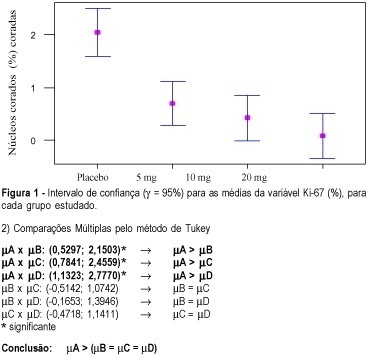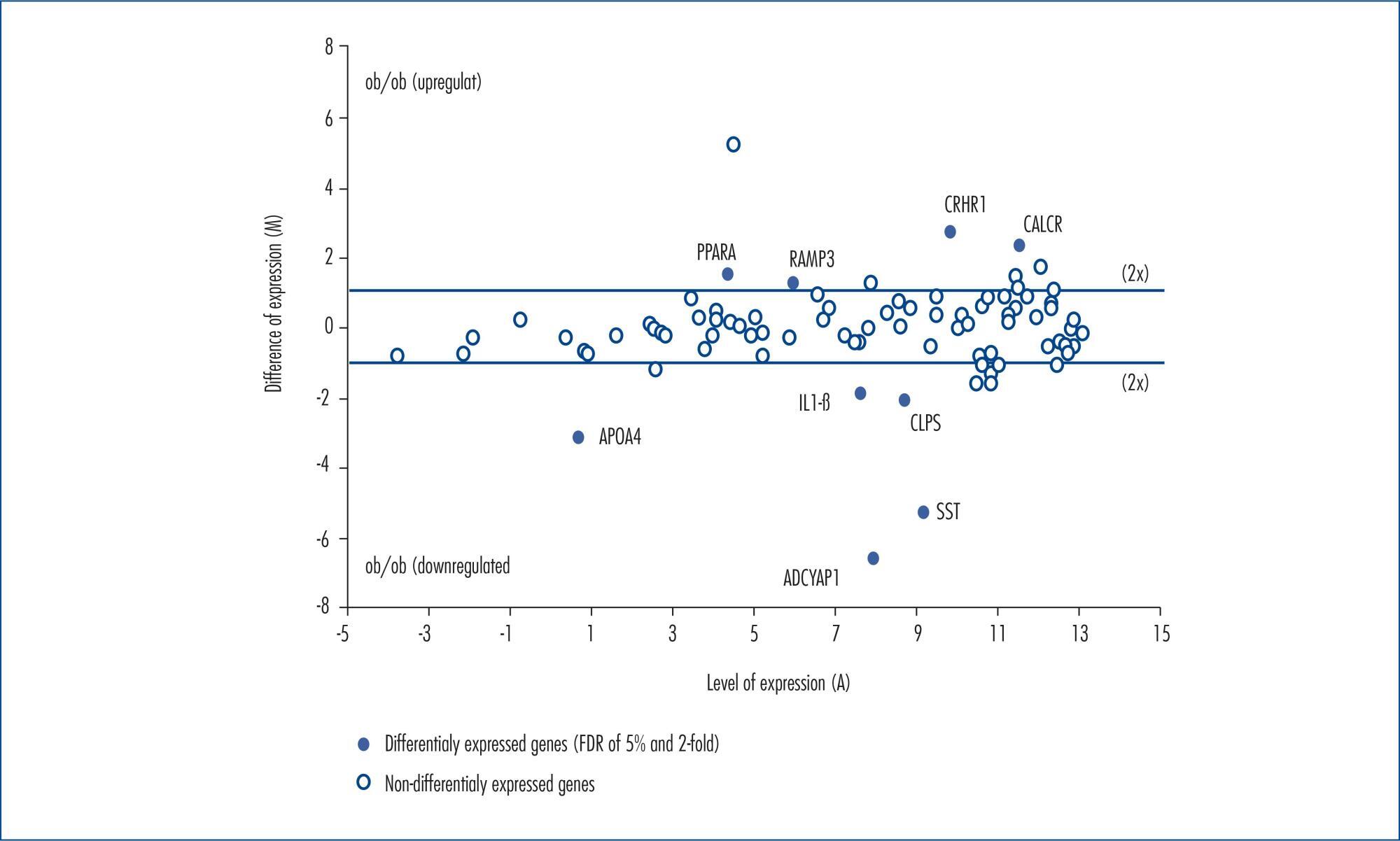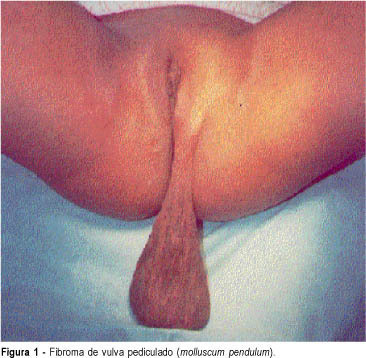Summary
Revista Brasileira de Ginecologia e Obstetrícia. 2003;25(3):185-191
DOI 10.1590/S0100-72032003000300007
PURPOSE: to quantitatively analyze the immunoreaction of monoclonal antibody Ki-67 in the mammary epithelium adjacent to fibroadenoma of premenopausal women treated with tamoxifen, for 50 days, at doses of 5, 10 and 20 mg/day. METHODS: we studied, prospectively, the effects of tamoxifen administered for 50 days, at doses of 5, 10 e 20 mg/day, by the immunoreaction of the Ki-67 (clone Ki-S5) monoclonal antibody on mammary epithelium adjacent to fibroadenoma in premenopausal women. We studied 58 patients in a double-blind trial who were divided into four groups: Group A (n=13; placebo), Group B (n=16; 5 mg/day tamoxifen), Group C (n=14; 10 mg/day) and Group D (n=15; 20 mg/day). All patients received the medication from the first day on of the menstrual cycle and biopsy was performed on the last day of the treatment. Cells stained and not stained by the immunoreagent were counted by optical microscopy (400X) with a digital image capturing system and image analysis. RESULTS: the average percentage of stained nuclei was calculated for all groups: Group A was 2.0 with a standard error (SE) of 0.3. In Group B it was 0.7 (SE=0.2); in Group C it was 0.4 (SE=0,2) and in Group D it was 0.1 (SE=0). Statistical analysis showed significant reductions between the groups (p<0.001), and Tukey's pairwise comparison test confirmed that there was a significant increase in the immunoreaction of the monoclonal Ki-67 antibody in groups B, C and D. CONCLUSIONS: tamoxifen, administered at doses of 5, 10 and 20 mg/day for 50 days, significantly reduced the immunoreaction of monoclonal Ki-67 in the mammary epithelium of premenopausal patients and there was no significant difference between the groups that received 5, 10 and 20 mg/day tamoxifen.

Summary
Revista Brasileira de Ginecologia e Obstetrícia. 2015;37(4):186-191
DOI 10.1590/SO100-720320150005252
To evaluate genes differentially expressed in ovaries from lean (wild type) and obese (ob/ob) female mice and cyclic AMP production in both groups.
The expression on messenger RNA levels of 84 genes concerning obesity was analyzed through the PCR array, and cyclic AMP was quantified by the enzyme immunoassay method.
The most downregulated genes in the Obesity Group included adenylate cyclase-activating polypeptide type 1, somatostatin, apolipoprotein A4, pancreatic colipase, and interleukin-1 beta. The mean decrease in expression levels of these genes was around 96, 40, 9, 4.2 and 3.6-fold, respectively. On the other hand, the most upregulated genes in the Obesity Group were receptor (calcitonin) activity-modifying protein 3, peroxisome proliferator activated receptor alpha, calcitonin receptor, and corticotropin-releasing hormone receptor 1. The increase means in the expression levels of such genes were 2.3, 2.7, 4.8 and 6.3-fold, respectively. The ovarian cyclic AMP production was significantly higher in ob/ob female mice (2,229±52 fMol) compared to the Control Group (1,814±45 fMol).
Obese and anovulatory female mice have reduced reproductive hormone levels and altered ovogenesis. Several genes have their expression levels altered when leptin is absent, especially adenylate cyclase-activating polypeptide type 1.

Summary
Revista Brasileira de Ginecologia e Obstetrícia. 2007;29(4):186-191
DOI 10.1590/S0100-72032007000400004
PURPOSE: to examine the hypothesis that serum anti-Müllerian hormone (AMH) levels reflect the ovarian follicular status. METHODS: Design: prospective study. Patients: we studied 101 IVF-ET candidates undergoing controlled ovarian hyperstimulation with GnRH agonist and FSH. After the achievement of pituitary suppression and before FSH administration (baseline), serum AMH, inhibin B, and FSH levels were measured. The number of antral follicles was determined by ultrasound at baseline (early antral follicles; 3-10 mm). RESULTS: at baseline, median serum levels of AMH, inhibin B, E2, P4 and FSH were 3.42±0.14 ng/mL, 89±4.8 pg/mL, 34±2.7 pg/mL, 0.22±0.23 ng/mL and 6.6±0.1 mIU/mL, respectively, and the mean number of early antral follicles was 17±0.39. Serum levels of AMH were negatively correlated with age (r=-0.19, p<0.04), and positively correlated with number of antral follicles (r=0.65, p<0.0001), but this did not apply to serum levels of either inhibin B, E2 or FSH. CONCLUSION: the data demonstrate an association between AMH and antral follicular counts. Therefore, AMH is probable a biomarker of ovarian follicular status.
Summary
Revista Brasileira de Ginecologia e Obstetrícia. 2023;45(4):186-191
Psychiatric symptoms are common mental issues in pregnancy and the postpartum period. There is limited information regarding the psychiatric symptoms of women with high-risk pregnancy in the postpartum period. This study aimed to compare the severity of psychiatric symptoms and psychological distress in women with high-risk and low-risk pregnancies in the postpartum period.
This case-control study examined 250 women in the postpartum period in two groups with low-risk (n = 112) and high-risk (n = 138) pregnancies. Women completed the Brief Symptom Inventory-53 (BSI-53) and the Risk Postnatal Psychosocial Depression Risk Questionnaire (PPDRQ).
The mean severity of psychiatric symptoms in women with high-risk pregnancies was significantly higher than that in women with low-risk pregnancies (39.34 ± 17.51 vs. 30.26 ± 17.08). Additionally, the frequency of psychological distress in women with high-risk pregnancies was approximately twice higher than that in women with low-risk pregnancies (30.3% vs. 15.2%). Furthermore, the risk factors for depression in women with high-risk pregnancies were almost 1.5 times (59.8% vs. 39.8%) higher than the factors in women with low-risk pregnancies. The results of the logistic analysis indicated that high-risk pregnancies could be twice the odds ratio of developing postpartum psychological distress (ß = 2.14, 95% CI 1.4-6.3, p= 0.036).
Psychiatric symptoms and the psychological distress index are higher in postpartum women with high-risk pregnancies than in postpartum women with low-risk pregnancies. The study suggests that obstetricians and pregnant women's health care providers should strongly consider screening of psychiatric symptoms in women with high-risk pregnancies both during pregnancy and after delivery as the women's routine care priorities.
Summary
Summary
Revista Brasileira de Ginecologia e Obstetrícia. 2001;23(3):187-190
DOI 10.1590/S0100-72032001000300009
A vulvar fibroma, of the molluscum pendulum type, was present in a 20-year-old patient. The tumor began to develop slowly after her menarche, when she was 14 years of age. The physical examination revealed a mass with considerable volume, painless, located at the upper third of the greator left lip, elastic consistency, greater diameter at its distal portion measuring 12 cm by 23 cm in length. The treatment was exeresis from the base of the pedicle, under local anesthesia. The tumor weighed 950 g. A literature review is included.

Summary
Revista Brasileira de Ginecologia e Obstetrícia. 1999;21(4):187-192
DOI 10.1590/S0100-72031999000400002
Purpose: analysis of histopathologic alterations caused by neoadjuvant chemotherapy (fluorouracil, epirubicine, cyclophosphamide; FEC - 4 cycles) at the tumor site, adjacent mammary tissue and homolateral lymph nodes, as observed in sections of patients with primary breast carcinomas. Method: histological studies performed on 30 surgical sections obtained from radical mastectomy (Patey) of patients with primary breast carcinomas, who underwent prior neoadjuvant systemic therapy. Results: all sections showed tumor regression with variable intensity. This regression occurred irregularly, several refractory tumor cells remaining at the primary tumor site. Resistant tumor cells, independent of the primary tumor, were found in mammary tissue. Other histopathological findings, resulting from chemotherapy in tumoral and mammary tissues, such as calcifications and fibrosis, and in axillary homolateral lymph nodes were obtained. Conclusion: the effect of neoadjuvant chemotherapy is not uniform, refratory tumor cells remaining not only at primary tumor site, but also in distant regions. Furthermore, we found no correlation between the regression of the tumor and the axillary metastatic lymph nodes. Thus, a conservative surgery after neoadjuvant chemotherapy (FEC) should be avoided.

Summary
Revista Brasileira de Ginecologia e Obstetrícia. 1998;20(4):187-192
DOI 10.1590/S0100-72031998000400003
The present study describes 13 cases of appendicitis in the gravidic-puerperal cycle, at the Maternidade Escola Januário Cicco, from Jan/89 to Dec/96. The cases were assisted by a team of obstetricians and surgeons. Eleven patients were pregnant (4 in the 1st trimester, 6 in the 2nd and 1 in the 3rd) and 2 were in the puerperal period. The incidence was 1/3.422; the age ranged from 18 to 30 years and the majority was nulliparous. The most frequent symptom was abdominal pain (intense or moderate). The appendix was perforated in 6 cases, 2 of them with abdominal wall abscess and 1 patient had an abortion. Pregnancy presented no complications in 9 cases, and delivery occurred at term. The authors observed that appendix perforations occurred more frequently in cases whose symptoms had begun earlier. The authors found that the earlier the diagnosis, the better the prognosis.